photos by Meredith and Dave Chenault
As I discussed previously, minimalist footwear can be used - and used well - for many things beyond the mild road and trail walking for which most such shoes were designed. Technical terrain can mean many things to different people, from fourth-class scrambling above treeline in the Sierra or San Juans to steep bushwacking in the Cascades or Wrangells. Many of the standard trails in the Adirondacks qualify, if one hews to the definition that technical terrain is anything on which a particular slip would result in broken bones.
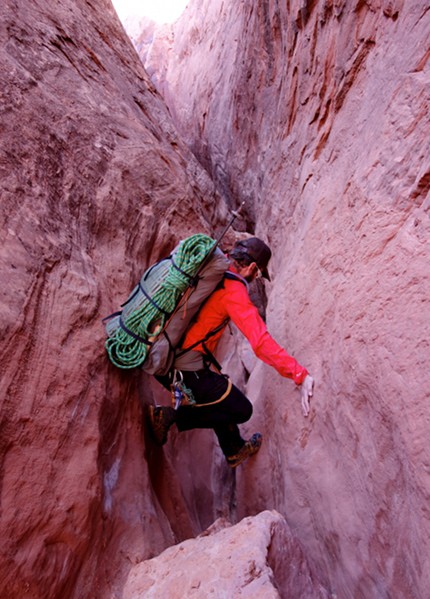
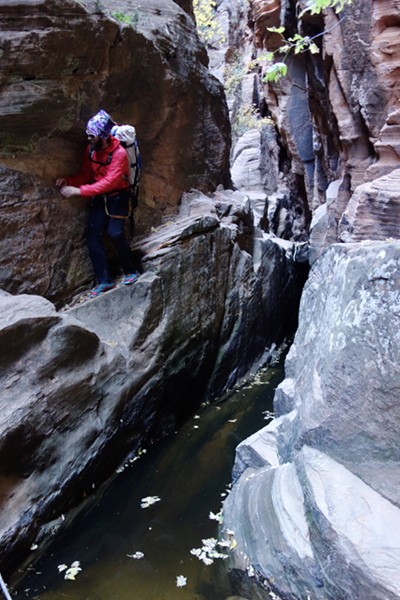
For anyone used to conventional shoes, hiking in minimalist shoes requires an often substantial transition period. Being able to use them in technical terrain requires an even more extensive period of foot, leg, and core strengthening and acclimation. This training is different in degree only, not kind. Anyone who can hike or run all day in minimalist shoes will find few limitations when using them in technical terrain, provided the acclimation period is not short-cutted. The transition from loaded talus busting in mountaineering boots to talus ballet, under a 30 pound pack and in a 10oz zero drop shoe, will probably be measured in years.
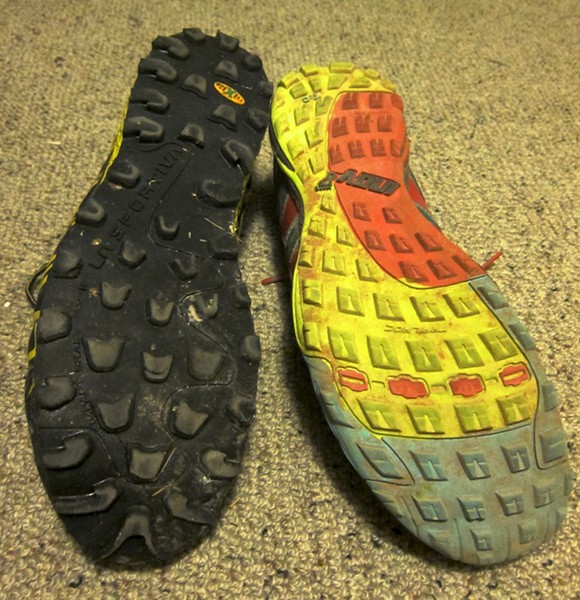
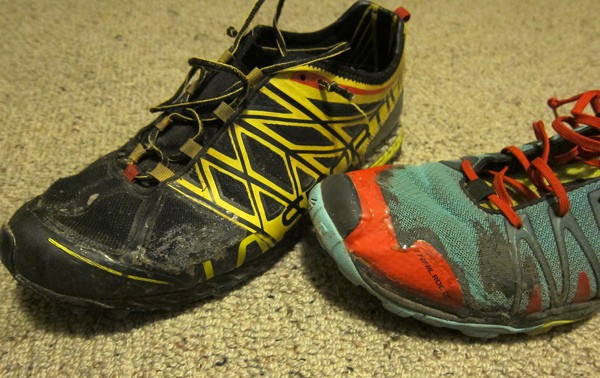
Beyond limitations associated with physical preparation, there are a number of external limitations associated with using minimalist shoes in technical terrain. I'll discuss these using two review shoes as examples: the La Sportiva Anakonda and Inov-8 Trailroc 235.
| Anakonda (size 45) | Trailroc (size 44.5) | |
|---|---|---|
| Weight (oz) | 12 | 9 |
| Heet-toe Drop (mm) | 4 | 0 |
| Forefoot Cushion (mm) | 8 | 6 |
Minimalist shoes will have varied levels of cushioning and stiffness, with the Anakonda being considerably stiffer than the Trailroc due to a forefoot rock plate. Any minimalist shoe will be much, much more flexible than the mountain boots usually recommended for technical alpine hiking. This means that edging on solid terrain and aggressive step kicking in loose terrain is not possible. Delicate smearing will be the rule, which makes sole traction and forefoot shape vital factors shaping performance.
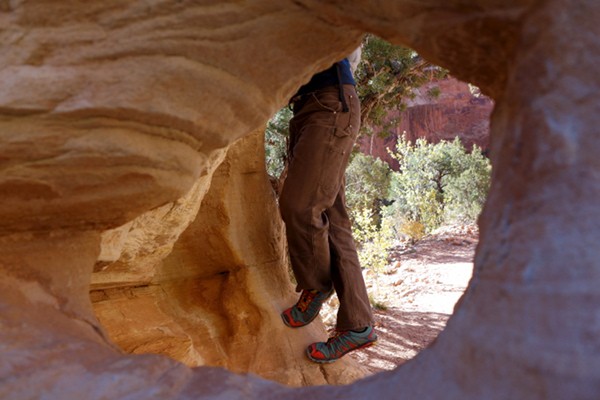
The traction inherent in the shoe is determined by the tread pattern and the type of rubber. Generally speaking, softer rubber provides more friction at the expense of faster wear. Also generally speaking, the more rubber surface which contacts the ground, the better the traction on rock and hard-packed dirt. This has to be balanced against surfaces like mud and scree, where the tread of the shoe needs to dig in. In sticky mud, tread needs to be widely spaced, so that mud will be disinclined to pack the shoe and vaporize traction.
The Anakonda tread is much more widely spaced than that on the Trailroc, as well as much deeper. Since La Sportiva first began using this tread on the Crosslite a number of years ago, it's been a personal favorite. The traction in mud and loose scree is outstanding, while the rubber is sticky enough and the lugs big enough to provide better than average friction on wet rocks. For the full spectrum of technical terrain, I've never used a better sole. The closer spaced, lower lugs of the Trailroc work very well, especially on less loose surfaces such as steep, compact dirt. They're less effective, but still decent, in mud. Unfortunately, the Trailrock rubber is not especially sticky, and mediocre at best on wet rocks. More durable rubber is a good idea to preserve the life of the smaller lugs, but comes with a price.
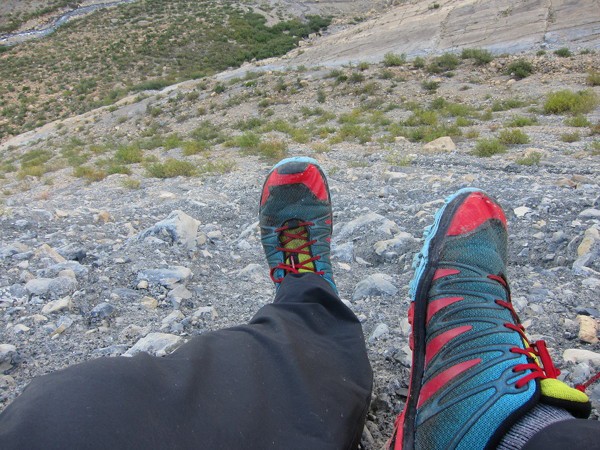
Forefoot shape almost equals tread and rubber in importance when using minimalist shoes in technical terrain. Wide, anatomic lasts are justly popular in minimalist shoes, as they allow the toes to splay which in turn releases the full potential of the foot muscles. However, for delicate footwork on small and steep stances the muscles of the foot need to be contained to a certain extent, in order to direct the bodys strength. The extreme of this is rock climbing slippers, which lack almost all structure in the midsole but can be used on tiny holds because they compress the foot both medially and laterally. This approach is not practical for walking any distance, but a certain degree is a good idea for technical terrain.
The forefoot on the Anakonda is a fair bit narrower than the Trailroc, which in combination with the rock plate make it much more confident climbing on small holds. As can be seen in the accompaning photos, the Anakonda sole has a hard edge, while the Trailroc is more rounded. The overall effect is that a shoe like the Anakonda is better for edging and smearing with a small portion of the toes and metatarsals, while a shoe like the Trailroc favors smearing with the whole forefoot. I also find the Trailroc more comfortable for plain hiking on trails or moderate off trail terrain. These two shoes are good examples of two different approaches in minimalist shoes for technical terrain. Both work, and both have their strengths and weaknesses. The choice between the two will be driven by terrain, personal preference, and of course that definitive arbiter of all things footwear: fit.
Fitting minimalist shoes intended for demanding terrain is a delicate balance between room enough for the foot to swell and function properly, without any additional room for sideways or forward movement within the shoe itself. As per usual, fit in the midfoot and heel must be snug without being tight. The Anakonda is a bit narrower than the anatomic last of the Trailroc. Unsurprisingly, the Anakonda felt more precise, while the Trailroc felt more comfortable.
Another limitation of minimalist shoes is that they are ill-suited for use with traction devices (crampons, microspikes, etc) and snowshoes. The lack of a sole at least as firm as even flexible crampons means that most minimalist shoes will twist out when snow gets steep. The flexible, thin, and low-cut uppers also don't provide much padding, and thus the cinch straps of crampons will tend to cut off circulation and make your feet get colder easier, which is not helpful in snow. A shoe like the Anakonda sorta works with flexible, strap-on, ten point crampons, but is uncomfortable and as mentioned marginally functional under anything other than easy snow travel. I've found that when I actually need crampons, I want a shoe with a stiffer sole and burlier upper, so that I can effectively kick steps and use french-technique with confidence. The Anakonda is well suited to traction devices such as microspikes, which often add just enough security for snowy or icy conditions with modest demands and consequences. Even microspikes are marginal on a shoe like the Trailroc, as the sole doesn't provide the amount of padding required to insulate the foot from the lumpy chains and spikes. Short periods of use are fine, but when I walk for more than a few miles or so with microspikes and a shoe like the Trailroc I being to feel the spikes underfoot. Do this for too long, and you'll be in a fair bit of pain.
Similar limitations concern the marriage of snowshoes and minimalist shoes. Snowshoe bindings put a fair amount of torsion on feet, and minimalist shoes are not ideal for providing enough structure to insulate feet from their influence. As with crampons, the straps can make it hard to keep your feet warm. Some snowshoes are better than others in this regard, and there's room to make a snowshoe which would be better suited to minimalist shoes, but if I'm going to be snowshoing for many miles on consecutive days, I'll want a more substantive shoe than either of the ones discussed here.
The final limiation normally associated with minimalist shoes is durability, or the lack thereof. Light weight is normally expected of minimalist shoes, and to a certain extent durability will inevitably be correlated with weight. More relevantly, minimalist shoes (especially insofar as they have evolved from trail running shoes) have been designed for use in tame and low-abuse terrain.
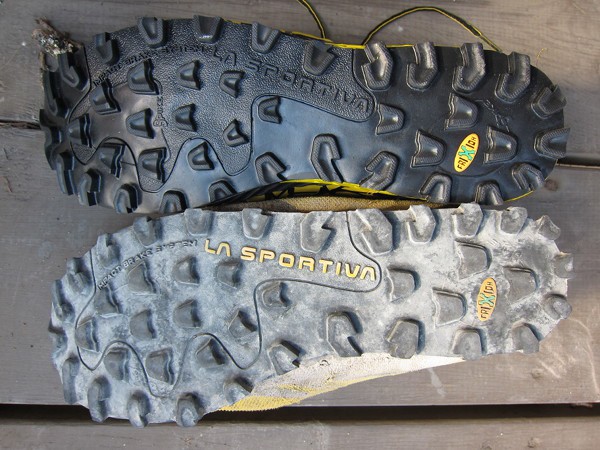
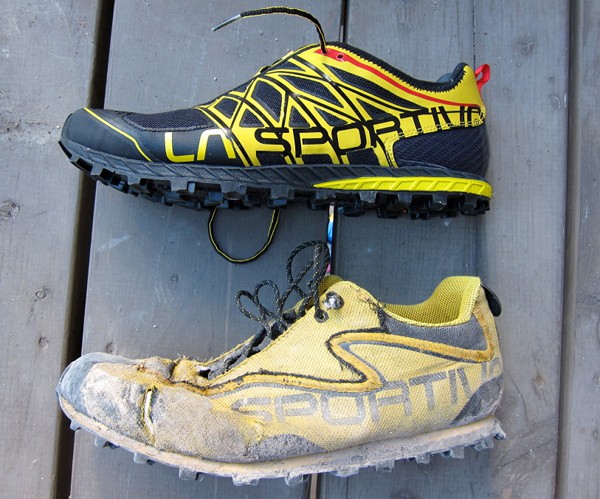
This is starting to change, and both of the shoes discussed here represent the extent to which more durable minimalist shoes are on the horizon. The Anakonda is a particularly good example. It's predecessor, the X Country, was 3 ounces a shoe lighter in the same size. The weight gain is purely in more durable upper fabrics and rubber along the side of the sole, to help prevent the sole delamination which plagued the X Country under hard use. The Anakonda is the first shoe I'd call minimalist where the upper seems likely to last as long as the sole.
In conclusion, minimalist footwear has a wide range of applicability in technical terrain, with remarkably few limitations provided the user has sufficient training and experience. With minimalist shoes becoming more the norm every year, durable shoes with suitable tread are likely to become more numerous, thus providing more options to address the crucial issue of fit. For more and more hikers, backpackers and peak baggers these shoes are a viable and expeditious option.
